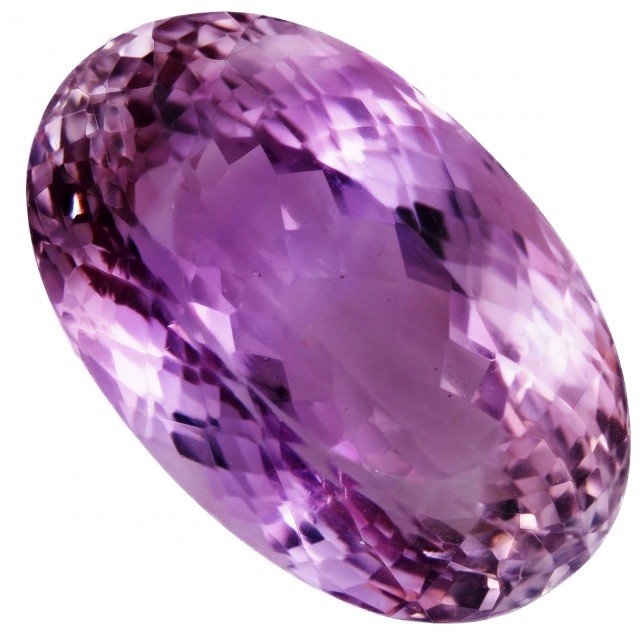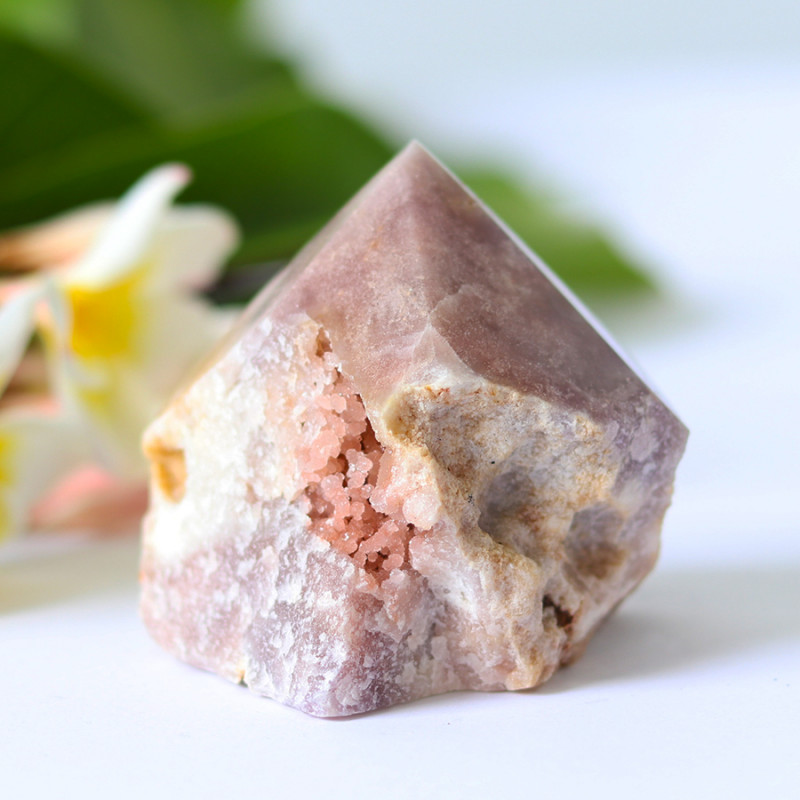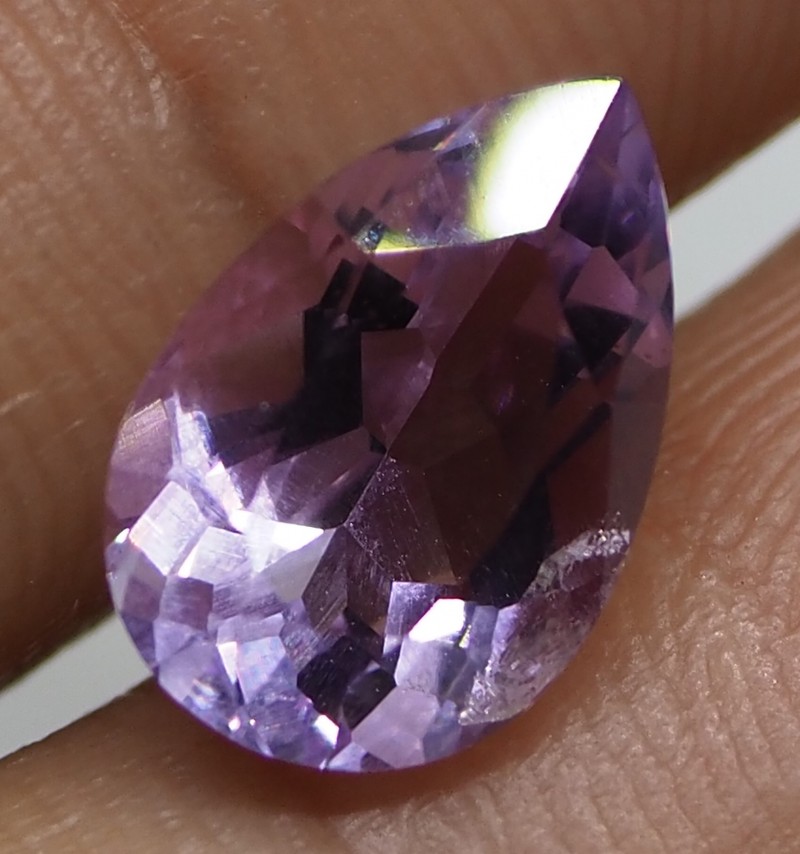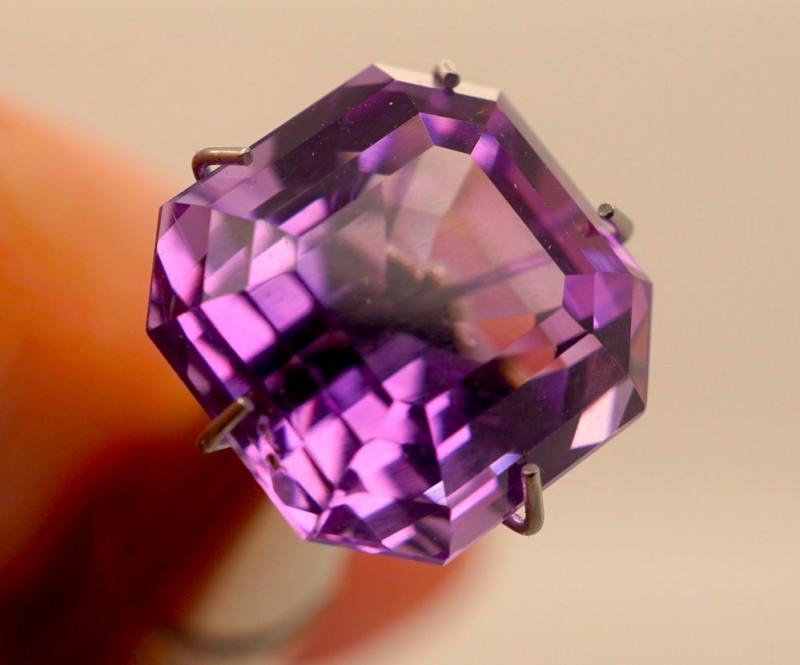
Rose de France Amethyst: Meaning, History, Properties and Value
 Do you love purple gems and pastel tones? Then get ready to fall in love with Rose de France amethyst! Rose de France is a lighter-toned variety of the beloved quartz stone amethyst and will have you swooning over its feminine aesthetic. Named for its soft lilac coloring, this beautiful gem is revered for its unique color properties and subtle elegance.
Do you love purple gems and pastel tones? Then get ready to fall in love with Rose de France amethyst! Rose de France is a lighter-toned variety of the beloved quartz stone amethyst and will have you swooning over its feminine aesthetic. Named for its soft lilac coloring, this beautiful gem is revered for its unique color properties and subtle elegance.
Rose de France hasn’t been around as long as most gemstones, but the stone has made a lasting impression all over the world.
The delicate hues of Rose de France are reminiscent of a quaint verbena field in springtime. Likewise, the stone’s spiritual properties will evoke similar feelings of peace and connection with nature.
Here, we’ll teach you everything there is to know about Rose de France amethyst and why this gem is so swoon-worthy.
First and foremost, what is Rose de France amethyst?
About Rose de France Amethyst
Rose de France is a beloved variety of amethyst sometimes called “pale amethyst” or “light amethyst.”
For anyone born in February, you can celebrate your own season of love with a gorgeous rose de france amethyst birthstone! As a zodiac stone for Pisces as well, rose de france is the perfect gift for celebrating end-of-the-season birthdays.
Speaking of celebrations, amethyst is the traditional gift for the 6th and 33rd wedding anniversaries!
If you know a couple who appreciates subtle beauty, a rose de france amethyst ring is a perfect gift to celebrate their milestone.
Mineral Characteristics
As a mineral, Rose de France amethyst is a macrocrystalline form of quartz, similar to stones like citrine and smoky quartz. The stone’s signature feature is its pale coloring, found in light shades of purple and pink.
Rose de France also displays a fascinating color phenomenon called pleochroism. This effect happens when you turn the gem in the light, you can see red and blue flashes at different angles.
What causes Rose de France’s color? Well, it depends on the shade.
Light purple Rose de France stones gain their coloring from small traces of iron and a natural irradiation process during their formation. Traces of titanium can also change the stone’s color, often giving the gem stronger pleochroism.
Luckily for Rose de France lovers, the gem ranks at a sturdy 7 on the Mohs hardness scale. In other words, the gem is suitable for daily wear, so you can flaunt a Rose de France necklace with any outfit!
Curious about Rose de France’s other properties?

Rose de France Specifications and Characteristics
Color: Light shades of purple, pink, or mauve
Crystal structure: Hexagonal
Luster: Vitreous (glass-like)
Transparency: Transparent to translucent
Refractive index: 1.54-1.55
Density: 2.6-2.7
Cleavage: None
Pleochroism: Present; Red and/or blue
With the scientific details out of the way, let’s take a look at Rose de France’s spiritual meaning.
Rose de France Amethyst Meaning
Rose de France joins the likes of French fries and French kissing as a moniker that has more to do with French symbolism than the French themselves. In fact, the first name for the stone was “Brazilian amethyst,” as Brazil was the exclusive supplier for many years.
The name “Rose de France” came along much later, most likely as a marketing technique to evoke the decadence and glamour associated with France.
Some claim the stone’s name came about due to a high demand for it in Europe during the Victorian era. However, historians have refuted this.
Rose de France seems to be a modern moniker, most likely a “Brazilian term for amethyst of pale lilac hue,” according to a 1977 dictionary from JCK Jewelers.
Origins aside, Rose de France amethyst symbolizes protection and serenity. As one of the few purple gemstones, Rose de France meaning signifies royalty, strength, and transformation.
What about rose de france amethyst metaphysical properties? How can you take advantage of Rose de France’s transformative abilities?

Rose de France Healing Properties
Like any crystal, Rose de France amethyst possesses powerful healing properties. So, what is amethyst good for?
Physically, Rose de France may ease problems with the endocrine system (where our hormones are) and the circulatory system.
The stone is also purported to help with low metabolism, reproductive health, and pain relief.
The Rose de France properties for emotional healing are equally impressive. The stone’s soothing energies provide peace and tranquility, allowing you to feel more comfortable trusting your intuition.
Rose de France can make us more comfortable in the workplace as well. This gem is known to enhance productivity and prevent stress-inducing communication mishaps.
Additionally, Rose de France may strengthen relationships, bringing us closer to our family, friends, and work colleagues.
If you’re looking to get closer to yourself through self-reflection and meditation, you can use Rose de France for chakra healing!
Rose de France Chakra Healing
Rose de France amethyst is a chakra healing stone for the center of spirituality, our crown chakra.
The crown chakra is the highest chakra in our body, where our spirit communicates with higher beings in the cosmos. In Buddhism, the crown chakra connects to the last stage of enlightenment known as “Great Bliss.”
When the crown chakra is blocked, we may be confused, dysfunctional, or detached. With Rose de France amethyst, you can open and balance your crown chakra again.
Once your crown chakra is balanced, you can get in touch with the universe and connect to things greater than yourself. Besides, what’s more valuable than connection?
Speaking of, is rose de france amethyst valuable? To answer that, we’ll need to break down the factors that determine the stone’s quality.
Rose de France Amethyst Gemstone Properties
Figuring out a gemstone’s value requires expert knowledge and lots of practice. As a consumer, however, you don’t have to be an expert to prevent getting swindled.
As long as you know what factors go into a stone’s value, you can buy with confidence! For Rose de France, the key factors include the gemstone’s cut, color, clarity, and treatment.
Cut
Rose de France’s high durability means the stone can handle virtually any cut, faceted or unfaceted.
Popular faceted cuts for Rose de France amethyst include oval, trilliant, and pear shapes. Any faceted cut can be used, and many artisans employ custom cuts to bring out Rose de France’s beautiful clarity.
Color
You’ve probably guessed by now that Rose de France’s color is its most striking feature. Available in light shades of pink, purple, or mauve, this stone embodies soft sophistication.
Rose de France’s tone grade is important for experts evaluating if the gem is real. Some gemologists insist that the stone must be a precise 4 on the GIA’s tone scale to be considered a “true” Rose de France.
Not all gemstone enthusiasts follow as strict a standard, however. If you love it, that’s all that matters!

Clarity
Many gem enthusiasts have heard that inclusions always devalue a stone. However, inclusions are present in almost every gemstone and often give colored stones their beautiful shades.
In Rose de France’s case, iron and aluminum inclusions contribute to its pale purple tones. Natural irradiation finishes the job, allowing the lovely lavender color to shine.
Most Rose de France stones have a Type II grade based on the GIA scale. A Type II grade means inclusions are almost always present, but you won’t be able to view them with the naked eye on high-quality rose de france gems.
Treatment
Because of Rose de France’s natural beauty, treatments are not very common. However, some Rose de France stones undergo heat treatment.
While heat treatment of Rose de France isn’t common, it’s not easy to detect. Sellers should specify if their stones have been heat-treated.
The main reason for heat-treating a Rose de France stone is to give the stone better transparency and lighter coloring.
Feeling more confident about your Rose de France knowledge? Great!
Now it’s time to go on a journey through history and mythology to uncover Rose de France’s past.
Rose de France Amethyst History
Rose de France was first discovered in Brazil in the 1800s. The history of Rose de France’s mother stone, amethyst, goes much further back to the legends of ancient Greece.
While details of the myth differ, the story of amethyst’s creation involves two Greek gods, Dionysus and Artemis, and a young woman named Amethyst.
The legend goes that Dionysus, offended by a mortal, vowed to take revenge on the next mortal he came across. Unfortunate timing meant the “next mortal” was Amethyst.
On her way to worship the goddess Artemis, Amethyst was unaware of her dangerous predicament. Artemis was aware, however, and protected Amethyst by turning her into a clear quartz statue.
Dionysus was so overcome with guilt, he cried tears of wine. His tears stained the statue purple and created the first amethyst stone.
The Greek myth of amethyst’s origin infused into Greek culture as well. Ancient Greeks believed an amethyst stone would prevent you from getting drunk, or at least too drunk.
Rose de France has touched many societies beyond Greece. But where does the stone come from? And how does Rose de France form in the first place?
Rose de France Amethyst Origins and Sources
Rose de France stones form in the same fascinating way as amethysts: inside geodes!
Geodes are slightly rounded rocks that have cavities of crystals hidden inside. Like an oyster, geodes must be cracked open to reveal the stunning treasure within.
Rose de France geodes grow in zones with volcanic activity. When magma is still hot, gas bubbles create pockets for liquid full of silica to crystallize in.
While the magma cools off and starts to harden, small amounts of iron in the quartz’s liquid silica base go to work. With help from a little radiation, that iron gives Rose de France stones their trademark lilac hues.
As you can see, Rose de France needs specific conditions to grow. So, where is Rose de France mined?

Mining Locations
When Rose de France was first discovered, southern Brazil was the only provider of this beautiful gem.
Today, most of the Rose de France gems on the market still come out of Brazil, particularly from the Minas Gerais and Maraba areas.
Other countries have started mining Rose de France, however. Productive Rose de France mines include the Anahi mine in Bolivia, as well as mines in Zambia, Russia, and Uruguay.
Uruguay and Brazil boast particularly luscious Rose de France deposits. The amethyst in these locales can take up entire cave walls!
Once the stone is excavated, experts take special care to get it ready for gem lovers like you. So once it’s in your hands, how do you care for amethyst?
Rose de France Care and Maintenance
Rose de France stones are pretty sturdy. The gem’s color is crucial to its beauty, however, you’ll want to know how to clean your gem to keep it shining bright.
The simplest cleaning method for Rose de France only requires a few items: warm water, mild soap, and a soft cloth.
You can either create a soapy solution to soak your gemstone in or use the soap to clean your gem under running water. Once the gem is clean, use the cloth to dry it off.
For maintaining the gem’s color and clarity over time, keep the stone away from:
Ultrasonic cleaners
Excessive heat
Harsh chemicals (e.g. household cleaning products)
Lastly, let’s go over how much a Rose de France jewel is worth.

Rose de France Amethyst Value and Prices
The key factor for rose de france amethyst price is its dispersion of color. A gem with even coloring and no bundles of color (known as color zoning) will command higher prices.
As any gemologist knows, the best way to show a gem’s color is with a good cut.
A skilled lapidary can remedy uneven color distribution in a Rose de France stone, making the gem more valuable. Some lapidaries get creative with custom cuts as well, which offer even higher value.
The rose de france price per carat for faceted stones with saturated coloring can range anywhere from $3-$30 per carat.
Faceted cuts for rose de france gems with weaker coloring ranges from $3-$6 per carat, while medium coloring falls at $16-$27 per carat.
Rough rose de france specimens are the most affordable option, with the average price per carat around $0.35.
Fall in Love with Rose de France!
With that, you’re now ready to share all your new knowledge on Rose de France! We think you’ll agree when we say that this gem is a subtle stunner with amazing qualities.
Along with its external beauty, Rose de France’s spiritual qualities mean the stone is brewing with potential.
Whether you’re seeking spiritual growth and serenity or just a cute new gem for your collection, Rose de France is the way to go!
Fall in love with a Rose de France amethyst today!
Search the Gemstone Encyclopedia
Related Auctions
Related Articles
Azotic treatment of Topaz and Quartz is a treatment that creates a layer of color over a gemstone. Learn more about this treatment and check out our stones fro sale.
8th May 2018
Quartz and Topaz are two of the most common minerals on the planet. They also look very similar. Let's look at some properties of them and compare Quartz and Topaz.
23rd Oct 2018
Gota De Aceite Emeralds have a special feature which increases their value. Read more about this rare type of Emerald and learn how it adds to the value.
9th May 2018
Latest Articles
Shortite is a rare mineral and rarer gemstone, usually found as colorless or yellow wedge-shaped crystals. Learn the value, history, and properties of shortite in this guide!
9th Dec 2024
Senarmontite is an uncommon antimony mineral mostly used industrially but occasionally collected as rare gems or pearly crystals. Find out all of the traits, uses, prices, and history of senarmontite.
27th Nov 2024
Tantalite is a group of red, brown, or black minerals containing the rare and valuable element tantalum. Discover the uses, history, prices, and properties of tantalite gemstones in this guide!
11th Nov 2024
Article Categories
How To's is where you will find helpful articles from gem Rock Auctions on how to cut gemstones, select gemstones and buy gemstones.
9 Articles





